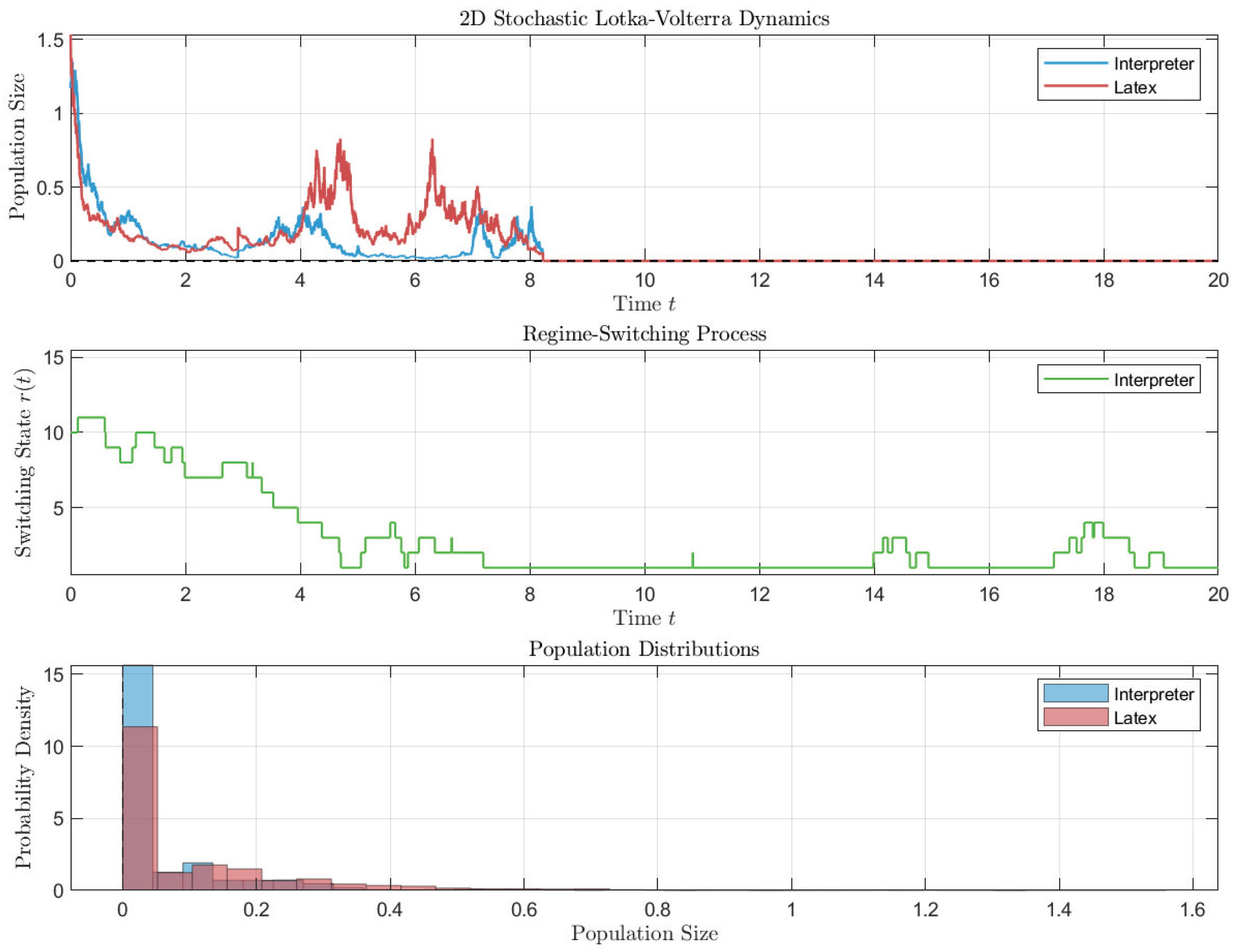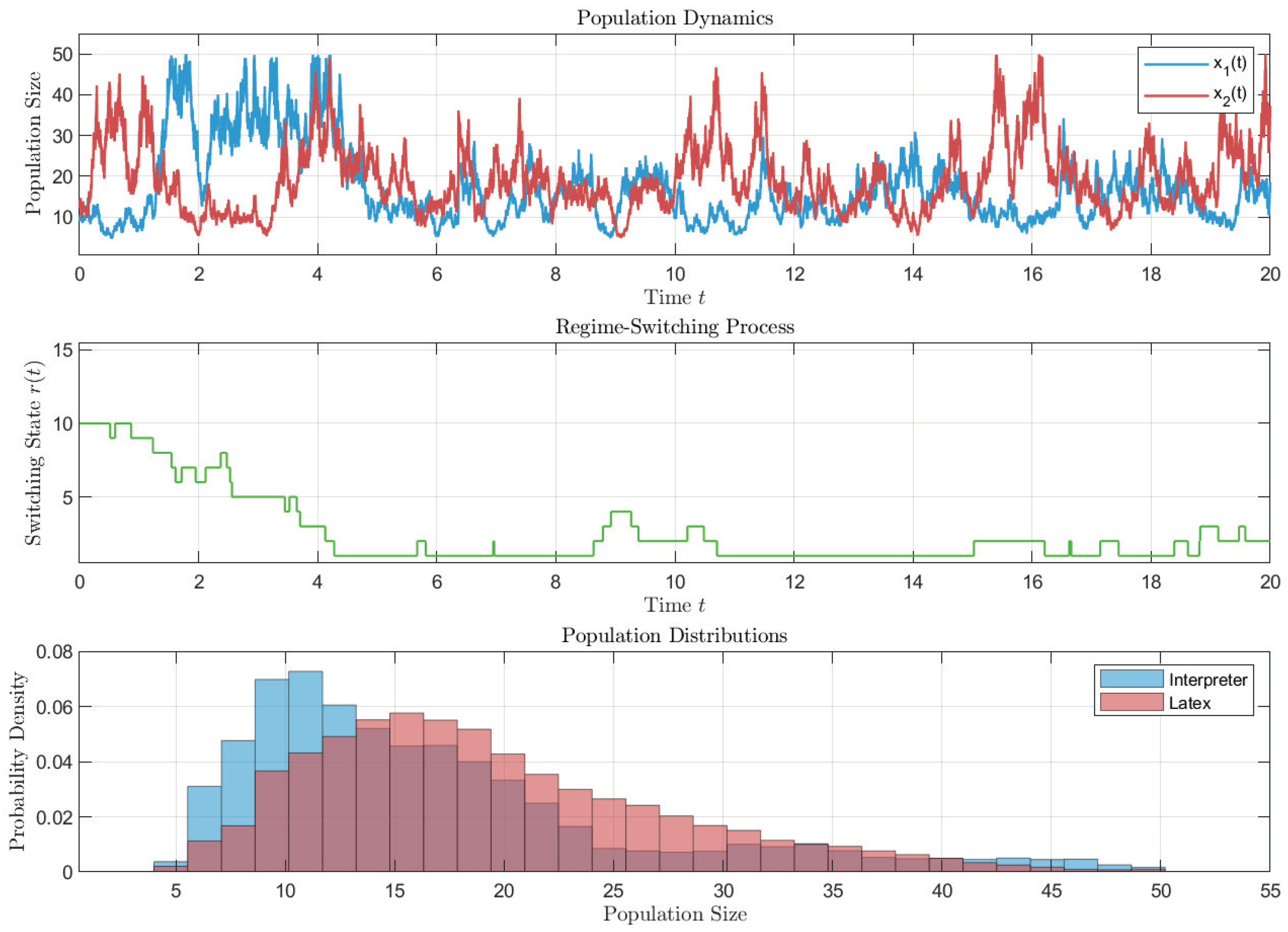Long-Term Behavior of Lotka–Volterra Model with Lévy Jump in Countable State-Dependent Environments
Abstract
1. Introduction
2. Preliminaries
2.1. Existence and Uniqueness of Positive Solution
- (A1)
- For all , , , , and there exists a positive constant such that
- (A2)
- The matrix is irreducible and conservative, i.e., , and
2.2. Stochastic Ultimate Boundedness
- (i)
- From the perspective of survival threshold, this property ensures that population size will not decay to zero or grow infinitely due to stochastic disturbances, providing theoretical support for the long-term persistence of populations.
- (ii)
- From the perspective of competitive balance, it restricts the fluctuation range of competing species’ abundances, preventing extreme proliferation or elimination of a single species and maintaining the dynamic coexistence among species.
- (iii)
- From the perspective of disturbance resistance, the bounded region and convergence rate quantify the population’s resilience to stochastic perturbations, offering a quantitative basis for assessing the stability of ecological systems.
- (A3)
- There exist positive constants satisfyingwhere denotes the diagonal matrix .
3. Extinction and Stochastic Permanence
3.1. Extinction
- (A4)
- For each , there exists a positive integer such that for all satisfying and all .
- (A5)
- and are irreducible, and and are the stationary distributions of and , respectively.
3.2. Stochastic Permanence
- (1)
- B is a nonsingular M-matrix.
- (2)
- All of the principal minors of B are positive, that is,
- (3)
- Every real eigenvalue of B is positive.
- (4)
- B is semipositive, that is, there exists in such that .
- (A6)
4. Examples and Numerical Simulations
5. Discussion
Author Contributions
Funding
Data Availability Statement
Acknowledgments
Conflicts of Interest
References
- Lotka, A. Elements of Physical Biology; Williams and Wilkins: Philadelphia, PA, USA, 1925. [Google Scholar]
- Volterra, V. Fluctuations in the abundance of a species considered mathematically. Nature 1926, 118, 558–560. [Google Scholar] [CrossRef]
- Khasminskii, R.; Klebaner, F. Long term behavior of solutions of the Lotka-Volterra system under small random perturbations. Ann. Appl. Probab. 2001, 11, 952–963. [Google Scholar] [CrossRef]
- Khasminskii, R.; Potsepun, N. On the replicator dynamics behavior under Stratonovich type random perturbations. Stochastics Dyn. 2006, 6, 197–211. [Google Scholar] [CrossRef]
- Mao, X.; Marion, G.; Renshaw, E. Environmental Brownian noise suppresses explosions in population dynamics. Stoch. Process. Their Appl. 2002, 97, 95–110. [Google Scholar] [CrossRef]
- Mao, X.; Marion, G.; Renshaw, E. Asymptotic behavior of the stochastic Lotka-Volterra model. J. Math. Anal. Appl. 2003, 287, 141–156. [Google Scholar] [CrossRef]
- Yin, G.; Zhu, C. Hybrid Switching Diffusions: Properties and Applications; Springer: New York, NY, USA, 2010. [Google Scholar]
- Chen, S.; Guo, Y.; Zhang, C. Stationary distribution of a stochastic epidemic model with distributed delay under regime switching. J. Appl. Math. Comput. 2024, 70, 789–808. [Google Scholar] [CrossRef]
- Shaikhet, L.; Korobeinikov, A. Persistence and Stochastic Extinction in a Lotka–Volterra Predator–Prey Stochastically Perturbed Model. Mathematics 2024, 12, 1588. [Google Scholar] [CrossRef]
- Ma, C.; Zhang, X.; Yuan, R. Dynamic analysis of a stochastic regime-switching Lotka–Volterracompetitive system with distributed delays and Ornstein–Uhlenbeck process. Chaos Solitons Fractals 2025, 190, 115765. [Google Scholar] [CrossRef]
- Don, S.; Burrage, K.; Helmstedt, K.; Burrage, P. Stability Switching in Lotka-Volterra and Ricker-TypePredator-Prey Systems with Arbitrary Step Size. Axioms 2023, 12, 390. [Google Scholar]
- Luo, Q.; Mao, X. Stochastic population dynamics under regime switching. J. Math. Anal. Appl. 2007, 334, 69–84. [Google Scholar] [CrossRef]
- Li, X.; Jiang, D.; Mao, X. Population dynamical behavior of Lotka-Volterra system under regime switching. J. Comput. Appl. Math. 2009, 232, 427–448. [Google Scholar] [CrossRef]
- Wu, R.; Zou, X.; Wang, K.; Liu, M. Stochastic Lotka-Volterra systems under regime switching with jumps. Filomat 2014, 28, 1907–1928. [Google Scholar] [CrossRef]
- Basak, G.; Bisi, A.; Ghosh, M. Stability of degenerate diffusions with state-dependent switching. J. Math. Anal. Appl. 1999, 240, 219–248. [Google Scholar] [CrossRef]
- Shao, J. Invariant measures and Euler-Maruyama’s approximations of state-dependent regime-switching diffusions. SIAM J. Control. Optim. 2018, 56, 3215–3238. [Google Scholar] [CrossRef]
- Ji, H.; Xi, F. Stationary distribution of stochastic population dynamics in state-dependent random environments. Syst. Control. Lett. 2020, 144, 104774. [Google Scholar] [CrossRef]
- Cloez, B.; Hairer, M. Exponential ergodicity for Markov processes with random switching. Bernoulli 2015, 21, 505–536. [Google Scholar] [CrossRef]
- Shao, J. Comparison theorem and stability under perturbation of transition rate matrices for regime-switching processes. J. Appl. Probab. 2024, 61, 540–557. [Google Scholar] [CrossRef]
- Xi, F.; Zhu, C. On Feller and strong Feller properties and exponential ergodicity of regime-switching jump diffusion processes with countable regimes. SIAM J. Control. Optim. 2017, 55, 1789–1818. [Google Scholar] [CrossRef]
- Bui, T.; Yin, G. Hybrid competitive Lotka–Volterra ecosystems: Countable switching states and two-time-scale models. Stoch. Anal. Appl. 2019, 37, 219–242. [Google Scholar] [CrossRef]
- Bao, J.; Shao, J. Asymptotic behavior of SIRS models in state-dependent random environments. Nonlinear Anal. Hybrid Syst. 2020, 38, 100914. [Google Scholar] [CrossRef]
- Berman, A.; Plemmons, R. Nonnegative Matrices in the Mathematical Sciences; Society for Industrial and Applied Mathematics: Philadelphia, PA, USA, 1994. [Google Scholar]




Disclaimer/Publisher’s Note: The statements, opinions and data contained in all publications are solely those of the individual author(s) and contributor(s) and not of MDPI and/or the editor(s). MDPI and/or the editor(s) disclaim responsibility for any injury to people or property resulting from any ideas, methods, instructions or products referred to in the content. |
© 2025 by the authors. Licensee MDPI, Basel, Switzerland. This article is an open access article distributed under the terms and conditions of the Creative Commons Attribution (CC BY) license (https://creativecommons.org/licenses/by/4.0/).
Share and Cite
Ji, H.; Yu, P.; Sun, H.; Zhen, Y. Long-Term Behavior of Lotka–Volterra Model with Lévy Jump in Countable State-Dependent Environments. Mathematics 2025, 13, 3566. https://doi.org/10.3390/math13213566
Ji H, Yu P, Sun H, Zhen Y. Long-Term Behavior of Lotka–Volterra Model with Lévy Jump in Countable State-Dependent Environments. Mathematics. 2025; 13(21):3566. https://doi.org/10.3390/math13213566
Chicago/Turabian StyleJi, Huijie, Ping Yu, Hongxia Sun, and Yuhang Zhen. 2025. "Long-Term Behavior of Lotka–Volterra Model with Lévy Jump in Countable State-Dependent Environments" Mathematics 13, no. 21: 3566. https://doi.org/10.3390/math13213566
APA StyleJi, H., Yu, P., Sun, H., & Zhen, Y. (2025). Long-Term Behavior of Lotka–Volterra Model with Lévy Jump in Countable State-Dependent Environments. Mathematics, 13(21), 3566. https://doi.org/10.3390/math13213566





